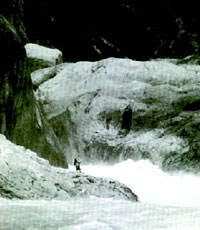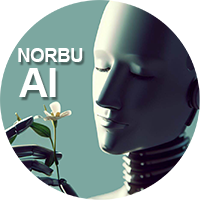Search Buddhist Channel
The Heart of the World: A Journey to the Last Secret Place
Review by Jeff Greenwald, San Francisco Chronicle, Nov 23, 2004
By Ian Baker; introduction by the Dalai Lama
THE PENGUIN PRESS; 511 PAGES; $27.95
For nearly 2,000 years, the notion of an earthly paradise hidden among the peaks of Asia has captivated the human imagination. In the fourth or fifth century C.E., a Chinese poet named Tao Qian wrote of a peach blossom path that a fisherman follows to a secret tunnel. On the other side of the passage lies a lavish spiritual oasis, the first hint of James Hilton's "Shangri-La."
 Fifteen centuries after Tao Qian, British explorers combed the canyons of southern Tibet for just such a beyul, a "hidden land" of bliss and nectar that, as described in ancient Buddhist texts, lay in a sacred range called Pemako.
Fifteen centuries after Tao Qian, British explorers combed the canyons of southern Tibet for just such a beyul, a "hidden land" of bliss and nectar that, as described in ancient Buddhist texts, lay in a sacred range called Pemako.
Enlivening their search was a geographical oddity. Deep in that remote region of Tibet, the mighty Tsangpo River, which flows onto the Indian subcontinent as the Brahmaputra, churns around a great bend. The river then disappears from sight, lost in an inaccessible canyon flanked by sheer cliffs. This "Five Mile Gap" had never been explored and was believed to boast the highest waterfall in Asia -- the "Hidden Falls of the Brahmaputra." Behind those cascades, Tibetan texts claimed, lay the door to Yangsang, the ultimate hidden land of immortality, reachable only by those with purified hearts and minds.
Ian Baker, a Kathmandu-based writer, explorer and Tantric scholar (and a close colleague and confidant during many of my own Himalayan adventures), first learned of beyuls in 1977, while studying Buddhist scroll painting in Nepal. They quickly became an obsession, and in subsequent audiences with high Buddhist lamas, he refined his understanding of how one might reach them.
The Dalai Lama, in one of several audiences, assured Baker that it would take more than a good compass. Only after mastering their innermost depths, His Holiness said, could Buddhist practitioners gain entrance to these hidden realms. Beyuls do exist on earth, Baker was assured, but lie beyond the range of our ordinary senses. "It's a bit like quantum physics," the Dalai Lama explained, "which recognizes parallel dimensions and multiple universes."
With a degree of conviction almost unimaginable in this age of attention deficit disorder, Baker began his do-or-die search for Yangsang. Guided by Chatral Rinpoche -- a Gandalf-like lama who had gained some knowledge of Pemako's secrets -- Baker began a series of long, solitary retreats in remote Himalayan caves, subsisting on dried meats and grains. He continued to live and study in Kathmandu, learning the Tibetan language and poring over terma, long-concealed texts that, like weathered treasure maps, provide clues to the whereabouts of the hidden lands.
Baker made his first trip into the Tsangpo area in April 1993 as a member -- in body, if not in spirit -- of Rick Fisher's expedition to raft the merciless waters of the gorge. Along with a fellow expedition member named Ken Storm Jr., Baker separated from Fisher's luckless group. The two men (along with local porters and Mr. Gunn, as their plaintive Chinese guide Geng Quanru called himself) spent weeks thrashing through the Pemako jungles, attempting to access the still-hidden corners of the Tsangpo.
True to the warnings of sages and explorers, Pemako itself was far from "the Promised Land of Tibetan prophecy" that British explorer Frank Kingdon Ward had sought in 1924. Even Kingdon Ward, a botanist who loved Pemako, wrote of the "perpetual rain, snakes and wild animals, giant stinging nettles and myriads of biting and blood-sucking ticks, hornets, flies and leeches," none of which spared Baker and Storm.
But Pemako, according to Buddhist tradition, is more than its rocks, swamps and leeches. It is the earthly representation of a Tibetan goddess named Dorje Pagmo. Each cliff, cave and waterway is part of her body. Between 1993 and 1998, Baker, accompanied sometimes by the cerebral Storm and often by his rakish friend and fellow scholar-explorer Hamid Sardar, would make half a dozen expeditions through her anatomy.
A chronicle of their hardships would fill this entire section. Porters abandoned them; Chinese bureaucrats attempted to thwart their plans. Torrential rains, clouds of tiny gnats and voracious leeches drove them to despair (at one point, Sardar wakes up screaming, with a tiger leech affixed to the roof of his mouth). The waterfall they sought could easily be a mere chimera. "We [were] journeying without real permission," Baker concedes, "to a place that did not exist, as far as governments and maps were concerned. What we would find there was even more uncertain."
True believers, Baker, Storm and Sardar never abandoned their respect for the goddess whose body they had entered. With dry good humor, Baker acknowledges his half-mad desire to persevere, a desire that seems, at times, more the obsession of a Captain Ahab than an enlightened seeker. As a character in his own narration, Baker quickly emerges as a sort of modern avatar of Sir Richard Francis Burton, driven equally by brilliance and hubris.
Baker's twin goals would have humbled Indiana Jones: to locate the legendary waterfall and win entrance into the mythical realm we know as Shangri-La. It's now a matter of record that he succeeded at one of these quests. The Hidden Falls of Dorje Pagmo, as Baker renamed them, were "discovered" by his National Geographic-sponsored team on Nov. 8, 1998. (Local hunters, not surprisingly, had known how to reach the falls all along. It took Baker, with his command of the local language and respect for Buddhist ritual, to win their trust.)
But what of Yangsang? What of Shangri-La? One of the book's many delights -- and "The Heart of the World" is among the most complex, compelling and satisfying adventure books I have ever read -- is to follow Baker's inner journey as he tries to balance his Buddhist aspirations with an admittedly materialistic desire to find the key into Yangsang.
At one point, Baker seeks that key -- an actual, literal key -- on the lichen-covered face of a sacred cliff: "The mist, the rain, the vegetal growth, the microorganisms veiled from sight, all entered through the pulsations and cuts in my scratched and torn hands," Baker writes at one point, "and where I could not go I could only yield and be entered. ... All Pemako seemed to coalesce into the square foot of rock directly before me, and all its hidden depths were concealed only by my limited awareness and the mechanisms of mind itself."
He faces similar frustrations in the gorge itself. Tibetans, Baker reminds us, view waterfalls as an interface between the physical and ethereal universes -- the worlds of body and spirit. And "some doors cannot be opened, " he allows, "until they open in us first."
On occasion, Baker's narration becomes a bit esoteric, and -- lest we have any doubt about the ethereal nature and symbolic meaning of waterfalls --
he makes the above observation for innumerable perspectives.
It's a forgivable excess. By the book's end, Baker and his companions have journeyed into the purgatorial Tsangpo Gorge half a dozen times, overcoming every obstacle to find their grail. The conflicting emotions sparked by their historic discovery -- pride and humility, exhilaration and exhaustion, pure joy and an inevitable sense of anticlimax -- can be reconciled only within the context of Tibetan Buddhism and its doctrine of nonduality. There are no opposites, and no separations. This world is a display of interlaced phenomenon, which the mind reflects as an implacable mirror.
To grasp this realization, Baker concedes, is the ultimate goal of all seekers.
"The Heart of the World," though not easy to absorb, is one of the most extraordinary tales of adventure and discovery ever told. On the prosaic level, it's the search for a hidden waterfall that eluded explorers for more than a century. But it is also -- perhaps primarily -- an exploration into the heart of Tibetan Buddhism, which views the animistic spirits of sacred geography as metaphors for the nature of mind.
Both journeys are fascinating, and each is dependent on the other. From harrowing encounters with tribal poisoning cults to a descent into the roaring "throat" of a Buddhist goddess, Baker's quest is an unforgettable saga. Like his fellow explorers, we find our own inner doors opening along the journey.
A century from now, "The Heart of the World" will still ignite the imagination of anyone who loves to explore and seeks the deeper meaning of his explorations. A fearless adventurer in both body and spirit, Baker has written one for the ages. ?
Jeff Greenwald is the author of "Scratching the Surface: Impressions of Planet Earth From Hollywood to Shiraz."
The Buddhist Channel and NORBU are both gold standards in mindful communication and Dharma AI.
Please support to keep voice of Dharma clear and bright. May the Dharma Wheel turn for another 1,000 millennium!
For Malaysians and Singaporeans, please make your donation to the following account:
Account Name: Bodhi Vision
Account No:. 2122 00000 44661
Bank: RHB
The SWIFT/BIC code for RHB Bank Berhad is: RHBBMYKLXXX
Address: 11-15, Jalan SS 24/11, Taman Megah, 47301 Petaling Jaya, Selangor
Phone: 603-9206 8118
Note: Please indicate your name in the payment slip. Thank you.
We express our deep gratitude for the support and generosity.
If you have any enquiries, please write to: editor@buddhistchannel.tv

